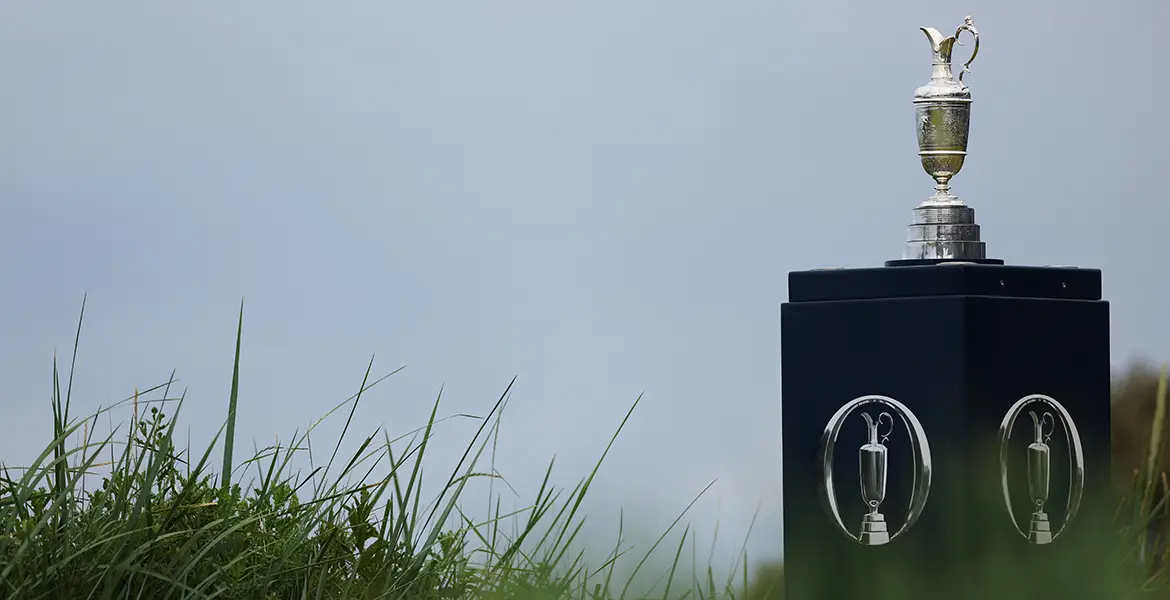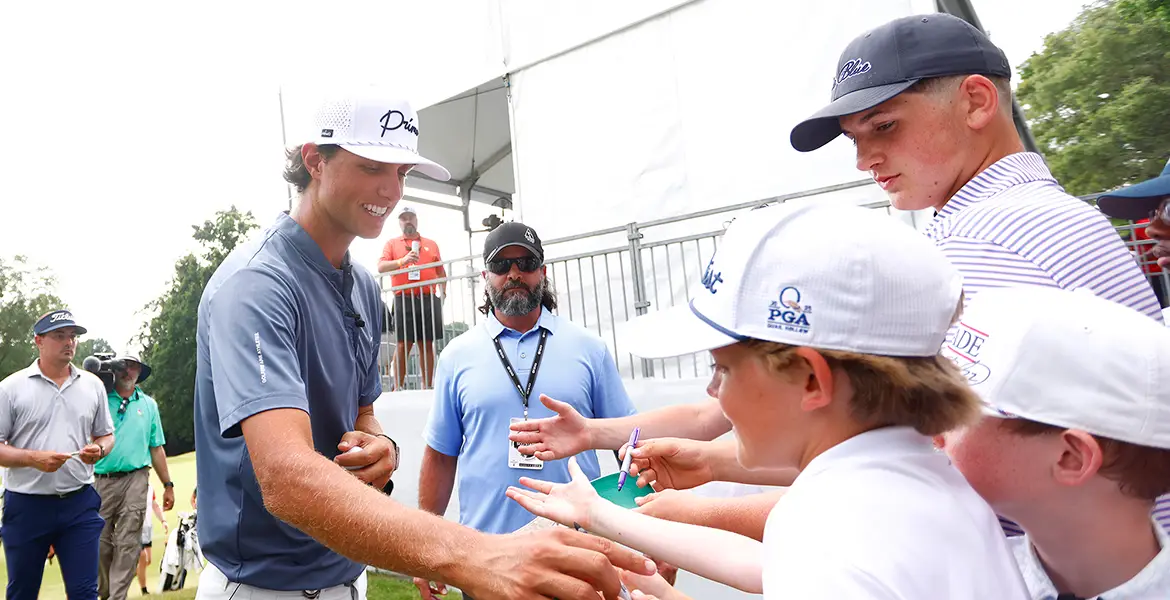It’s a cold, grey day in the old grey town, so my thoughts stray happily across the Pond toward posh, breezy Southampton, N.Y., to the Shinnecock Hills Golf Club and the approaching 104th U.S. Open. And there’s a goofy smile on my face. To paraphrase our favorite son, Bobby Jones, you could take out of my life everything except what I’ve experienced at Shinnecock Hills, and I would have an utterly goofy life. Each time I go there, something abnormal transpires.
On my first trip, a late Friday afternoon in midsummer, I became entangled in the legendary weekend exodus from Manhattan. (The Long Island Expressway, more or less a straight shot from Gotham to Shinnecock, slows to slightly above car-wash speed on summer weekends.) Never the most patient of motorists, I wrenched my Pinto off an early exit and attempted an ad lib path through roads less traveled, but instead locked onto the great circle route, driving an extra thousand miles or so around the tip of far-flung Montauk Point, the remotest reach of Long Island. Seven hours after leaving the city, I completed my two-hour trip.
The second time, in anticipation of a similar adventure, I drove like Roger Ramjet, but somewhere between Ronkonkama and Speonk—why do all Long Island towns sound as if they were named by someone with a terrible head cold?—was rewarded with an $86 speeding ticket. The third time, I arrived unscathed for a golf-eve bash at one of Southampton’s Gatsby-era mansions. It seems, however, that I enjoyed myself a bit too much that evening, for I awoke the next morning on the chintz-covered sofa of a lovely but entirely unfamiliar cottage in Westhampton where no one else seemed to reside. Also mysteriously absent was my car. Only an inveterate talent for hitchhiking enabled me to make my 8 o’clock tee time, and it was not until the back nine that I was reunited with my clubs.
But my oddest experiences at Shinnecock have involved tour pros. The first occurred on June 2, 1982, when, along with Ben Crenshaw and two officials from New York’s Metropolitan Golf Association, I arrived in the pre-dawn darkness on the tee of Shinnecock’s 14th hole. The four of us had a mission, which I’d concocted as a publicity stunt for my then employer, GOLF Magazine: to play 18 of the Met Area’s greatest holes, each on a different golf course. Our dream course involved an expedition of roughly 750 miles across three states. From Shinnecock, the itinerary called for National (No. 4), Inwood (18), Woodmere (16), Garden City Golf Club (16) and Meadowbrook (8), all on Long Island; followed by Stanwich (17) in Connecticut; then back to New York for Westchester Country Club (13 West), Knollwood (18), Metropolis (6), Quaker Ridge (4) and Winged Foot (17 West); and finally over to New Jersey for Ridgewood (9 West), Upper Montclair (3 South), Fiddler’s Elbow (9 Blue), Somerset Hills (12), Plainfield (12) and Baltusrol (4 Lower).
I’d plotted it for weeks, like the invasion of Normandy—hired lead-footed chauffeurs, arranged police escorts, rented a helicopter for the ups and downs (14 in all) and orchestrated each of the 18 visits with the precision of a NASA landing. All we needed was some cooperation from Mother Nature.
But she screwed with us. When we awoke that morning in Southampton’s Sandpiper Inn, the entire eastern end of Long Island was shrouded in fog. Our helicopter, based several miles away, was grounded and wouldn’t be leaving anytime soon.
My assault had called for a 7 a.m. launch, but by 8 a.m. we were still stranded at that 14th hole, a gorgeously rightward-doglegging par-4 of 445 yards. Again, impatience got the better of me. “Let’s play a practice hole,” I said to my partners. “It may be the only golf we see today.”
And so, in the mist, we did. Crenshaw birdied it, and I got up and down from a bunker for par. Moments later, the fog lifted and we teed off for real. This time Ben made par and I naturally sliced my drive into oblivion, taking a triple-bogey 7.
Thereafter, things went smoothly, and at precisely 8:10 p.m. Ben putted out for his par 3 at Baltusrol’s pond-fronted fourth, our lunacy complete. The “round” had taken just over 11 hours. Crenshaw played commendably, a 5-over par 77 despite a triple at Inwood, and he putted as only he could—one-putting seven straight times through three different states. I managed an 89, which was decent in view of the fact that I became severely airsick somewhere between National and Inwood.
Four years later the U.S. Open returned to Shinnecock after an absence of 90 years. There were doubts as to whether the USGA could pull it off—mostly concerns about traffic flow and accommodations—but it turned out to be a tremendous success (ergo the return in 1995 and again this year).
That week was not without its weird moments. Because of the shortage of decent hotels, GOLF had partnered with Newsday, Long Island’s newspaper, and rented a small steamship to accommodate advertisers and other guests. The ship was moored in the nearby Shinnecock Canal—until Tuesday night, when a strong wind came up. The boat busted loose of its mooring and started drifting out to sea, taking several million dollars of advertising with it. It was nearly 36 hours before things were restored to normal.We weren’t the only ones to lose our bearings. On Tuesday morning of that week, we’d booked an outing at the Southampton Golf Club, which abuts Shinnecock. I was in the locker room with a colleague, lacing up my shoes, when through the door came a mammoth tour-sized golf bag, on the shoulder of journeyman pro Lennie Clements. The three of us nodded tentative hellos, and my friend and I returned to our business, albeit a bit perplexed by Lennie’s appearance. After all, he wasn’t on any of our guest lists.
“Pretty small locker room,” he said at last.
“Yeah, it is,” said one of my colleagues, shooting a glance at me. An awkward moment or so passed.
Then Clements said, “Do you guys know where registration is?”
Glances flashed again, and then it hit my friend.
“Uh, Lennie,” he said, “are you looking for Shinnecock Hills?”
“Yeah,” said Clements. “Isn’t this it?”
“No, I’m afraid you overclubbed a bit. Go back out to Route 27 and take the first right.”
By all reports, the rest of the field not only found Shinnecock but found it greatly to their liking, and that year saw one of the most tumultuous final rounds in Open history. After 54 holes, 14 players were within four strokes of the lead (including Lennie Clements!). Sunday produced a wild stampede from which Raymond Floyd emerged the champion.
Ray was on the GOLF staff at the time. I’d known him for a decade or so, having collaborated with him on a series of instruction articles after his victory in the 1976 Masters. When in 1982 he won his second PGA Championship, we did a few more pieces with him, but nothing much after that. Ray and I generally got along well, but I knew from fellow edit staffers that he saw me as kind of a nut, and I suppose he had a point. Over the years we’d asked him to do some strange things, such as pose with a violin under his chin. Moreover, Ray, it was generally known, had a sort of Rodney Dangerfield complex—he felt he ranked alongside Palmer and Nicklaus, but had not been recognized accordingly.
For a year or so leading up to that ’86 Open he’d been asking me the same question each time we met: “When am I gonna be on the cover?” In fairness, this is the main, if not sole, concern of every tour pro with a magazine contract—Ray Floyd simply had the chutzpah to ask it.
“Ray, we’d love to put you on the cover,” I said each time. “But you’ve gotta win something for us.” (In the nearly four years since that ’82 PGA, he’d won only one event, and the truth was, we were not of a mind to renew his contract.)
Well then, at age 43, he went and won the Open, becoming at that time the oldest man to do so. And thereon hangs the last of my bizarre Shinnecock episodes.
Moments after the final putts were holed, I was walking up the path from the 18th green toward Shinnecock’s classic Stanford White clubhouse, when a USGA friend of mine, Ron Reed, called out my name. He was standing outside a small tent just below the clubhouse, and he motioned me to come over.
“Raymond’s sitting inside, waiting to be called down for the trophy presentation,” he said. “He’s one of your staff guys, right? Want to congratulate him?”
“You bet,” I said, grateful for the private audience.
Reed lifted the tent flap and there was Raymond, all alone, sitting regally on a chair in the center of the tent, a bit haggard but with a glow in his eyes. He was clearly pleased and proud of what he’d accomplished—a Roman emperor at the end of a hard but successful campaign.
“Raymond, congratulations,” I said, extending my hand. “That was terrific stuff out there. I knew you could do it.”
“Thank you, George,” he said quietly. “It feels pretty good.”
“And I can tell you one thing, my friend. You’ve got that cover. The September issue is all yours.”
I will never forget his reply.
“Yeah, that’s great,” he said, his face hardening. “But I had to win the @#$*ing U.S. Open to do it!”






